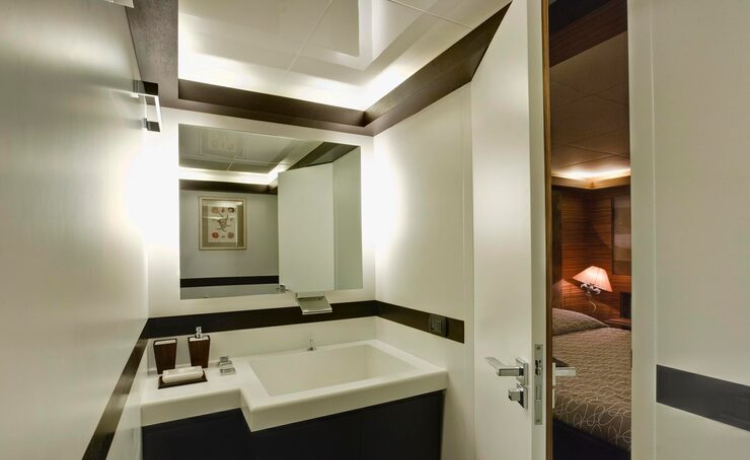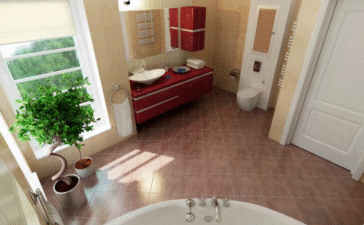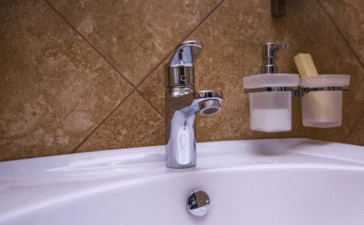Proper lighting transforms a bathroom from a purely functional space into a safe, relaxing sanctuary. The right light fitting bathroom ceiling is crucial, not just for ensuring you can see clearly, but also for setting the mood. Good bathroom lighting design balances bright, clear task lighting with soft, ambient light. With an array of modern options available, from sleek recessed downlights to statement pendants, choosing the perfect waterproof lighting can feel overwhelming. This guide will illuminate the path, helping you select a fixture that is safe, stylish, and perfectly suited to your needs.
Understanding light fitting bathroom ceiling
A light fitting bathroom ceiling is a fixture specifically designed to operate safely in the damp and humid conditions of a bathroom. These fixtures are built to resist moisture and are rated for safety in different areas of the room. The most common types each serve a distinct purpose.
Flush mount lights sit directly against the ceiling, making them an excellent choice for bathrooms with low ceilings. They provide broad, even illumination and their sealed design offers good protection against moisture.
Semi-flush lights hang a short distance from the ceiling, creating a soft glow of light both downwards and upwards towards the ceiling. This creates a more dimensional, ambient effect than a standard flush mount bathroom ceiling light.
Recessed downlights are installed into the ceiling, offering a clean, minimalist look. A recessed bathroom light fitting is ideal for modern bathrooms and can be strategically placed to highlight specific areas or provide overall task lighting.
Pendant lights hang from the ceiling on a cord or chain. While a pendant ceiling light can make a bold style statement, it must be carefully placed and have the correct safety rating for bathroom use, especially near water sources.
LED panel lights are large, flat fixtures that provide bright, uniform, and glare-free light. An LED ceiling light fitting of this type is highly energy-efficient and perfect for creating a bright, contemporary feel.
Bathroom Zones and Safety Ratings (IP Ratings Explained)
Safety is the most important factor when choosing bathroom lighting. To ensure safety, bathrooms are divided into zones, and light fittings have an Ingress Protection (IP) rating. This rating indicates how well the fixture is protected against solids (like dust) and liquids (like water).
Zone 0 is inside the bath or shower tray itself. Any fitting used here must be low voltage (max 12V) and be totally immersion-proof, requiring a rating of at least IP67.
Zone 1 is the area directly above the bath or shower up to a height of 2.25 meters from the floor. A light fitting in this zone requires a minimum rating of IP65, which protects against jets of water from any direction.
Zone 2 covers the area stretching 0.6 meters outside the perimeter of the bath and to a height of 2.25 meters from the floor. It also includes the area around the sink. A light fitting here needs to be at least IP44 rated. An IP44 bathroom light fitting is protected against splashes of water.
Any area outside these zones is considered an “outside zone,” where a specific IP rating is not technically required. However, using at least an IP44-rated waterproof ceiling light throughout the bathroom is highly recommended due to general humidity and condensation.
Choosing the Right light fitting bathroom ceiling
Selecting the best fixture involves balancing practical needs with aesthetic preferences.
Consider the size of your bathroom and its ceiling height. Large, high-ceilinged bathrooms can accommodate dramatic pendant lights, while smaller spaces benefit from the unobtrusive design of flush or recessed lights.
The light output, measured in lumens, determines the brightness. A typical bathroom requires around 500-600 lumens per square meter. A main ceiling light should provide a significant portion of this.
Color temperature, measured in Kelvin (K), affects the mood. Warm white (2700K-3000K) creates a cozy, relaxing ambiance, while cool white (3500K-5000K) provides a brighter, more energizing light that is ideal for task areas like vanities. The best color temperature for a bathroom often combines both, using dimmers or separate fixtures.
Your lighting style should complement your bathroom decor. Whether you prefer a modern light fitting bathroom with clean lines or a more traditional fixture, ensure it aligns with your overall design vision.
Finally, think about energy efficiency. LED fixtures consume significantly less power and last much longer than traditional halogen bulbs, making them a smart, cost-effective choice.
Design Ideas and Trends for light fitting bathroom ceiling (2025 Update)
Bathroom lighting design is constantly evolving. For 2025, several trends are taking center stage.
Minimalist and contemporary styles remain popular, with integrated LED fixtures providing a seamless, clean look. These fixtures blend directly into the ceiling architecture for an ultra-modern aesthetic.
Smart and dimmable bathroom lights are becoming standard. The ability to adjust brightness and even color temperature allows you to switch from bright, functional task lighting to soft, ambient light with a simple voice command or app.
Statement pendant or cluster designs are being used to create a focal point, especially over freestanding tubs or in powder rooms. A designer ceiling light for your bathroom adds a touch of luxury and personality.
In terms of finishes, matte black and brushed nickel continue to dominate modern bathroom ceiling light ideas, offering a sophisticated alternative to traditional chrome.
Installation Guide: How to Install a light fitting bathroom ceiling
Installing a bathroom ceiling light requires careful attention to electrical safety. While this is an overview, it is strongly recommended to hire a certified electrician for any bathroom electrical work.
First, the power to the circuit must be shut off at the main fuse box. The old fixture is then carefully removed, and the existing ceiling light wiring in the bathroom is inspected. The mounting bracket for the new fixture is installed, followed by connecting the wires: live to live, neutral to neutral, and ground to ground. The new fixture is then secured to the bracket, the bulb or LED module is installed, and the cover is attached.
Installing a fixture with or without attic access can change the complexity of the job, especially for recessed lighting. A professional can ensure all connections are secure and watertight, which is critical in a bathroom environment. Replacing an old fitting with a retrofit LED bathroom light is often straightforward, but always double-check compatibility and safety ratings.
Troubleshooting & Maintenance Tips
Even the best light fittings can encounter issues. If your bathroom ceiling light is not working, check the bulb and the circuit breaker first. Flickering can be caused by a loose bulb, an incompatible dimmer switch, or a wiring issue.
Moisture damage is a serious concern. If you see condensation inside a fixture, turn off the power immediately and have it inspected by an electrician. The seal may have failed, creating a safety hazard. Regular cleaning can prevent buildup that might compromise seals. To clean fittings, use a soft, damp cloth and avoid harsh chemicals.
For fixtures with replaceable components, follow the manufacturer’s instructions for changing bulbs or LED modules. Preventing condensation and corrosion starts with proper ventilation, so always use your bathroom’s extractor fan.
Energy Efficiency & Sustainability
Switching to an LED ceiling light for your bathroom is one of the smartest upgrades you can make. LED lights use up to 85% less energy than halogen bulbs, drastically reducing your electricity bills. A low wattage bathroom light with LED technology can produce the same brightness as a high-wattage incandescent bulb.
The long lifespan of LEDs—often over 25,000 hours—means you won’t be replacing bulbs for years, reducing waste and long-term costs. Look for Energy Star-rated fittings to ensure you are choosing a highly efficient and eco-friendly lighting option.
Brand Recommendations & Product Comparisons
Several brands are known for producing high-quality, top-rated bathroom ceiling light fittings. Astro Lighting and Eglo are praised for their designer aesthetics and robust build quality. More accessible options from retailers like IKEA, Philips, and B&Q also offer a wide range of reliable and stylish IP-rated fixtures.
When comparing products, consider the material. Metal finishes like chrome or brushed nickel offer durability, while plastic or polycarbonate fittings can be a more affordable waterproof light fitting option. Flush and recessed lights provide a more modern, integrated look, while semi-flush and pendants offer more decorative flair.
Where to Buy light fitting bathroom ceiling
You can find a wide selection of fixtures at major home improvement stores like Home Depot, B&Q, and Screwfix, as well as online retailers like Amazon. When you buy a bathroom ceiling light online, carefully check the product specifications to confirm its IP rating and dimensions.
To ensure you’re getting a certified waterproof fixture, look for the IP rating clearly stated in the product description. Buying from reputable retailers also ensures you receive a genuine product with a valid warranty.
Expert Insights & Real-World Experience
Interior designers often advise layering light in a bathroom. Use a central ceiling fixture for general ambient light, supplemented with task lighting at the mirror and accent lighting to highlight architectural features. A common mistake homeowners make is installing only one central light, which can create shadows and feel harsh. Electrician advice consistently emphasizes placing IP65-rated fittings in shower areas and never compromising on safety ratings.
Also Check: “lighting bathroom lighting“
Your Next Steps for a Brighter Bathroom
Choosing the right light fitting for your bathroom ceiling is a decision that balances safety, function, and style. By understanding bathroom zones, IP ratings, and the different types of fixtures available, you can create a space that is both beautiful and safe. Prioritize energy-efficient LEDs, select a style that complements your decor, and always consult a professional for installation. With the right lighting, your bathroom can become your favorite room in the house.
Frequently Asked Questions (FAQ)
What IP rating do I need for a bathroom ceiling light?
For a ceiling light placed directly over a shower or bath (Zone 1), you need a minimum rating of IP65. For most general ceiling areas outside this immediate zone (Zone 2), an IP44 rating is sufficient and recommended to protect against splashes and condensation.
Can I use a normal light fitting bathroom ceiling?
It is not safe to use normal, non-IP-rated ceiling lights in a bathroom. The moisture, steam, and potential for splashing water create a serious electrical hazard. Always use a light fitting with an appropriate IP rating for the specific zone in which it will be installed.
How many lumens do I need for my bathroom ceiling?
The required brightness depends on the size of your bathroom. A good rule of thumb is to aim for 500-600 lumens per square meter. For an average-sized bathroom of 5 square meters, you would need a total of 2500-3000 lumens, which can be achieved by combining a central ceiling light with vanity lights.
Are LED ceiling lights safe for bathrooms?
Yes, LED ceiling lights are perfectly safe for bathrooms, provided they have the correct IP rating for their location. In fact, because they run at a lower temperature than traditional bulbs, they can be an even safer option.
How high should a light be above a bathroom mirror?
Task lighting above a mirror should typically be mounted around 2 meters (78 inches) from the floor. This positioning helps illuminate the face evenly without casting harsh shadows. However, sidelights (sconces) placed on either side of the mirror at eye level often provide more flattering, shadow-free illumination.
What is the best color temperature for a bathroom?
The best approach is to use layered lighting with different color temperatures. For task lighting around the vanity where you apply makeup or shave, a neutral or cool white (3500K-4500K) is ideal as it renders colors accurately. But general ambient lighting, a warmer white (2700K-3000K) can create a more relaxing, spa-like atmosphere. Also dimmable fixture allows you to adjust the mood as needed.











